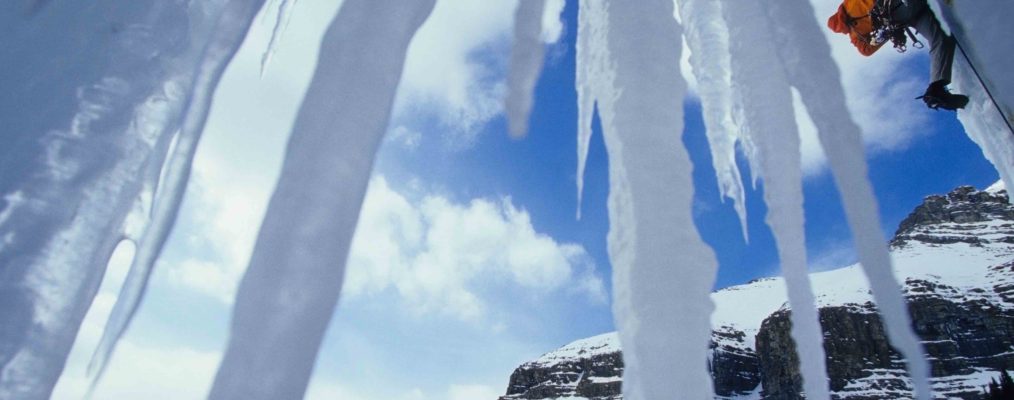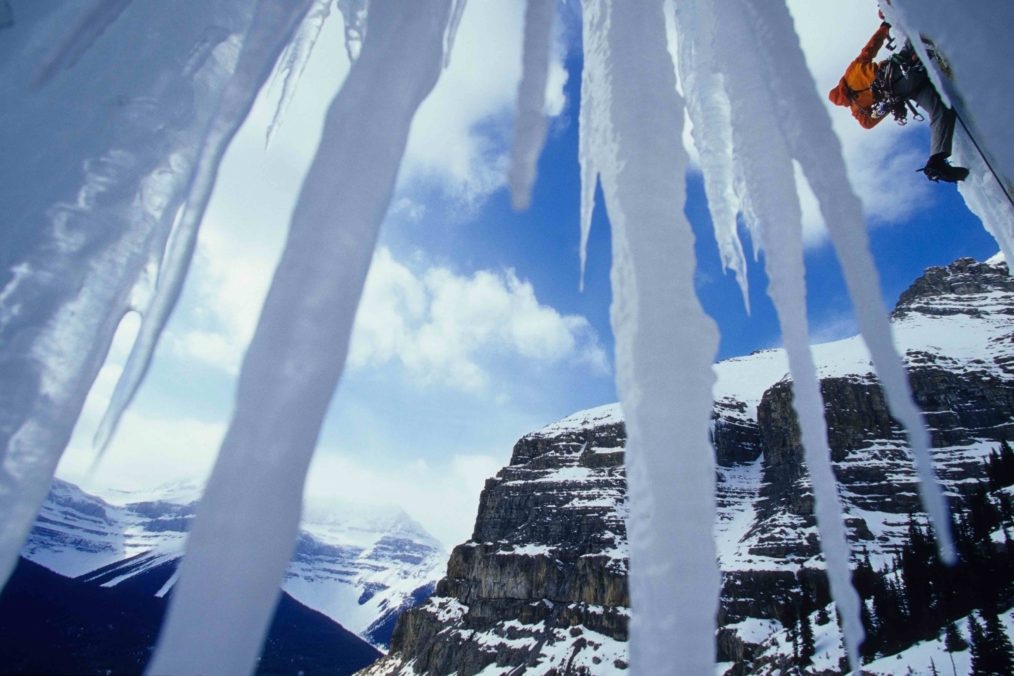Noone has commented on this article yet.
The Canadian Rockies provide what is perhaps the most extensive collection of quality ice climbs in the world, with the added bonus that the consistently cold temperatures that chill the entire mountain range mean that there is guaranteed to be ice to climb every season. Covering a large geographical area, the Canadian Rockies could be split down into lots of smaller destinations, each with a wealth of climbing, but a visiting climber is likely to travel around the whole of the range ticking off the classics in each of the areas. As well as offering great climbing, there is also good skiing and alpine climbing in the area, and hundreds of thousands of tourists visit each year to marvel at the stunning alpine landscape but leave the National Park fairly deserted out of season, all of which makes a trip here in winter extremely worthwhile.
Icefields Parkway
The Icefields parkway is an ice climber’s paradise, a 230km long road running north from Lake Louise to Jasper, lined with world class ice lines, many of which start from the road. Classics of the area include the extremely roadside Weeping Wall (WI4-5) and Polar Circus (WI5, 700m!), with plenty of good easier routes like Snivelling Gully (WI3) and Bow Falls (WI3-4) meaning that there’s something for everyone. Driving the parkway is an experience in itself, cutting through spectacular alpine scenery on a grand scale. If you get bored of the lifetimes worth of ice climbing on offer the area also has great ski touring alongside some very big, serious alpine climbing challenges.
Bow Valley
The Bow valey, which runs from Canmore in the east to Lake Louise in the west, has some of the best easily accessible ice climbs in the Rockies, all within striking distance from the well served towns of Canmore and Banff. Classics include Cascade Waterfall (WI3), The Professor Falls (WI4) and Louise Falls (WI4-5), and for those looking to test their mettle the Trophy Wall with its world famous lines such as The Terminator (WI5+-6+) and Sea of Vapours (WI7) is located right in the middle of the action.
The Ghost
Climbing in the Ghost is pretty adventurous, with a rough 4×4 accessible track leading into a very back-country environment. The routes often require long walks to their bases, but those who put the effort in will be rewarded by some of the biggest ticks in the Rockies, with big scale classics such as The Sourcerer (WI5), Hydrophobia (WI5+), Cryophobia (M8, WI5) and The Real Big Drip (M7, WI7) all up for grabs.
Kananaskis Country
An hour or two’s drive from Canmore, Kananaskis country has plenty of easily accessible ice spread over a geographically large area, reached by a large road loop taking you to the foot of lots of quality climbs. Classics of the area include R&D (WI4), Moonlight (WI4) & Snowline (WI4), and Whiteman Falls (WI6).
Radium Highway
The Radium highway, which runs south from the Bow Valley, has two popular venues that visiting climbers should consider. The first is the world class Stanley Headwall, famous for its collection of big, hard, ice and mixed climbs all set in a challenging alpine environment. Classic ice climbs such as Nemesis (WI6) and French Reality (WI6+) have in recent years been complimented by cutting edge trad-protected mixed lines such as Raphael Slawinski’s Victoria’s Secret Deviation (M7+). The other Radium Highway venue of interest to visiting climbers is Haffner Creek. Very much at the opposite end of the commitment scale, this roadside crag, which isn’t threatened by avalanche danger, has a selection of short ice and bolted mixed lines, all of which can be easily top-roped.
Yoho National Park
The small village of Field in the Yoho National Park is home to a host of easily accessible, top quality ice climbs throughout the grades. Short walk-ins combined with easy abseil descents make this place feel like low-commitment cragging, and a great place to get lots of climbing done. That said, many of the routes are threatened by avalanches coming down from the big bowls above the routes, so checking the avalanche forecast before heading out to climb is essential. Classics of the area include Guiness Gully (WI4), Carlsberg Column (WI5) and Pilsner Pillar (WI6).
gravsports-ice.com is the website to visit for all things Canadian Rockies ice and mixed climbing, with a active forum full of up to date conditions reports, as well as all sorts of useful information for the visiting climber.
The National Park Service website has some very important advice about avalanche avoidance when ice climbing in the area, including lists of where to climb and where to avoid under different forecasts.
How to get there
Most people will fly into Calgary, which is an hour’s drive east of the Rockies. The large distances between ice climbing venues and the lack of public transport to off the beaten track parking lots means that to get the most out of a trip to the Rockies a vehicle is needed, and hiring a car in Calgary is the simplest solution. When choosing a vehicle to hire it is well worth making sure that it has snow tyres and a set of snow chains, as getting to many of the best climbing areas can involve driving along occasionally snow-covered roads. If you plan on heading into the Ghost range then hiring a four-wheel drive vehicle will be well worth the additional cost.
Where to stay
There are hostels and hotels in all of the major climbing areas. A good way to approach a trip would be to start with a few nights in Canmore climbing in the Bow Valley, Kannanaskis and Ghost areas, before moving on to stop in Field. Frome here, a few nights spent in the beautiful wilderness hostels on the Icefield Parkway is a must. The Alpine Club of Canada has a clubhouse and hostel just outside of Canmore, which is a great place to stay.
Outfitters
There are numerous guiding outfits operating in the Rockies, who provide ice climbing courses and guided ascents of classic icefalls. The biggest and longest established outfit is Yamnusca Mountain Guides, based in Canmore. It is also possible to directly hire local IFMGA qualified mountain guides, who will offer personalised guiding services.
There are several independent gear shops in Canmore, Banff and Jasper, selling everything that you might need for your trip. Calgary has a huge Mountain Equipment Co-op, which is worth a visit at the start of your trip, to pick up any gear that you may need at reasonable process.
Permits
Much of the ice climbing lies within the Banff national park, and a permit to allow you to stop within this is available for purchase from the park gates as you drive on the highway from Canmore to Banff.







